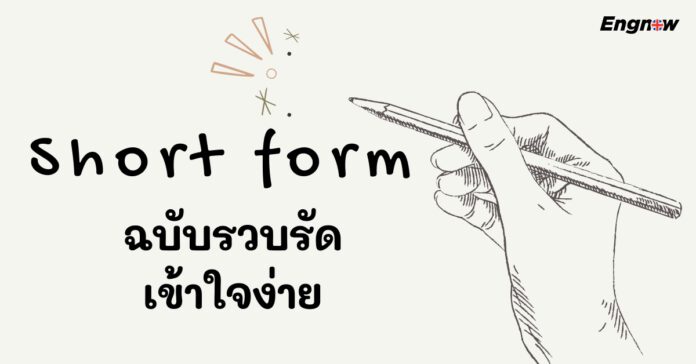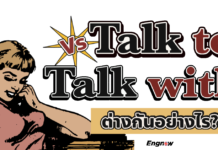ในภาษาอังกฤษนั้นเราจะมีรูป form ที่เรียกว่า short from ตัวอย่างเช่น he’s, I’d, don’t ซึ่งนั่นก็คือการรูปนั้นเอง ในการพูดภาษาอังกฤษเรามักจะออกเสียง I am เป็นคำเดียว ซึ่งรูป short from ของมันก็คือ I’m จึงเป็นลักษณะหนึ่งของการเขียนคําอย่างเช่นตัวอย่างดังต่อไปนี้
- I am → I’m = I’m feeling tired this morning.
- It is → It’s = Do you like this jacket? Yes, it’s very nice.
- They have → They’ve = Where are your friends? They’ve gone home.
.
.
.
เวลาที่เราเขียน Short form เราใช้ ’ หรือ an apostrophe ตัวอย่างเช่น
I am ก็จะเป็น I’m
He is ก็จะเป็น He’s
You have ก็จะเป็น You’ve
She will ก็จะเป็น She’ll
.
.
.
และสิ่งที่กำลังจะพูดต่อจากนี้นั่นก็คือหลักการใช้ Short form กลับ Personal pronouns ต่างๆ
- am / ’m / I’m
- is / ’s / he’s / she’s /it’s
- are / ’re / we’re / you’re / they’re
- have / ’ve / I’ve / we’ve / you’ve / they’ve
- has / ’s / he’s / she’s / it’s
- had / ’d / I’d / he’d / she’d / we’d / you’d / they’d
- will / ’ll / I’ll / he’ll / she’ll / we’ll / you’ll / they’ll
- would / ’d / I’d / he’d / she’d / we’d / you’d / they’d
ตัวอย่างก็อย่างเช่น
- I’ve got some new shoes. ฉันมีรองเท้าใหม่
- We’ll probably go out this evening. เราคงจะออกไปข้างนอกเย็นนี้
- It’s 10 o’clock. you’re late again. ตอนนี้ 10:00 น คุณมาสายอีกแล้ว
.
.
.
และเนื่องจากมีบางรูปที่เขียนย่อเหมือนกัน แต่ตัวรูปเต็มนั้นไม่ได้เหมือนกัน อาจจะสามารถสร้างความสับสนได้ อย่างไรก็ตามควรดูที่บริบทของประโยคนั้นๆว่าควรเป็น Tense ไหนเป็นหลัก แบบนี้จะช่วยได้เยอะ ตัวอย่างเช่น
’s = is หรือ has เช่น
- She’s going out this evening. เธอจะออกไปข้างนอกเย็นนี้
(ดูได้จากรูปที่เป็นของ Present Continuous เราจึงสามารถรู้ได้เลยว่า ‘s คือ is) - She’s gone out. เธอออกไปแล้ว
(ดูได้จากรูปที่เป็นรูปของ Present Perfect เราจึงสามารถรู้ได้เลยว่า ‘s คือ has สามารถสังเกตได้จาก gone)
’d = would หรือ had เช่น
- A: What would you like to eat? คุณอยากทานอะไร
B: I’d like a salad please. ฉันต้องการสลัด
(ดูได้จากรูปที่เป็นของ would เนื่องจากประโยคคำถามนั้นใช้ would เหมือนกัน ดังนั้น ‘d ก็คือ would ) - I told the police that I’d lost my passport. ฉันบอกตำรวจว่าฉันทำพาสปอร์ตหาย
(แน่นอนว่าประโยคนี้เป็นประโยคที่เกิดขึ้นเรียบร้อยแล้วในอดีต จึงต้องใช้ Present Perfectสังเกตได้จากคำว่า lost ดังนั้น ‘d จึงเป็น had)
.
.
.
นอกเหนือจากนี้เราสามารถใช้ Short form คำอื่นได้ด้วยนอกเหนือจาก Personal pronouns ตัวอย่างเช่น
- Who’s your favourite singer?
นักร้องคนโปรดของคุณคือใคร? (มาจาก who is) - What’s the time? (= what is)
ตอนนี้เป็นเวลาเท่าไหร่แล้ว (มาจาก what is) - There’s a big tree in the garden. (= there is)
มีต้นไม้ต้นใหญ่อยู่ในสวน (มาจาก there is) - My sister’s working in London. (= my sister is)
พี่สาวของฉันทำงานอยู่ที่ลอนดอน (มาจาก my sister is) - Peter’s gone out. (= Peter has)
ปีเตอร์ออกไปแล้ว (มาจาก Peter has) - What colour’s your car? (= What colour is )
รถของคุณสีอะไรหรอ (มาจากWhat colour is )
.
.
.
เอาล่ะเราได้พูดถึงการใช้คำที่ลดรูปในรูปแบบของการบอกเล่า ทีนี้มาดูกันว่าถ้าเป็นรูปย่อปฏิเสธหรือ negative short form จะมีอะไรบ้าง
- isn’t (is not) / don’t (do not) / can’t (cannot)
- aren’t (are not) / doesn’t (does not) / couldn’t (could not)
- wasn’t (was not) / didn’t (did not) / won’t (will not)
- weren’t (were not) / wouldn’t (would not)
- hasn’t (has not) / shouldn’t (should not)
- haven’t (have not) / mustn’t (must not)
- hadn’t (had not) / needn’t (need not)
ตัวอย่างเช่น
- We went to her house but she wasn’t at home.
- Where’s David? I don’t know, I haven’t seen him.
- You work all the time. You shouldn’t work so hard.
- I won’t be here tomorrow.












